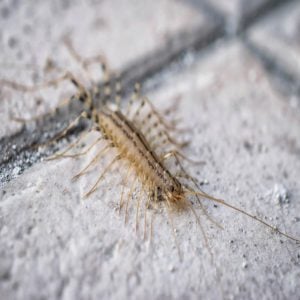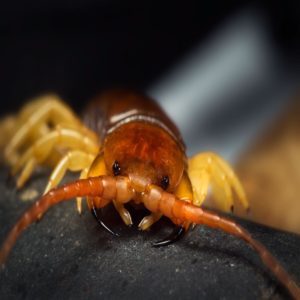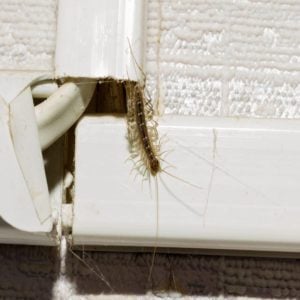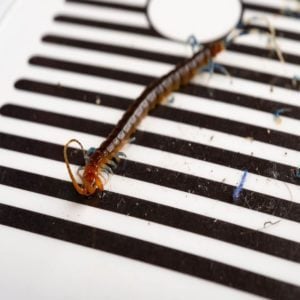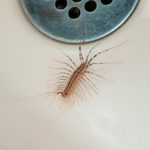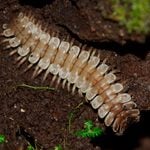How to Identify and Get Rid of House Centipedes
Fast and agile, the "hundred-legged" centipede is a beneficial and terrifying household pest.
Have you ever seen a many-legged creature scurrying so fast across the ground that you take a second look to make sure you actually saw it? If so, there is a chance you encountered a centipede.
This critter is a common household pest, seeking out a moist environment and solid food source in the comforts of your home. While not overly dangerous to people, a centipede might not be a welcomed guest.
On This Page
What is a centipede?
Distinguishable by their long body and numerous legs, centipedes belong to the Chilopoda insect class within the Myriapoda subphylum, which contains other leggy insects like millipedes.
Centipedes can have a few dozen pairs of legs to a few hundred, which is how they got their name. In Latin, “centi” refers to 100, and “ped” or “pedis” mean feet. Whenever this insect is around your home, its speed and legs can be a discomforting sight.
Types of Centipedes
There are more than 8,000 centipede species in the world, appearing on every continent except Antarctica.
The most common is the Scutigera coleoptrata, otherwise known as the house centipede. This yellowish-grey centipede will typically be a few inches long with more than 15 pairs of legs, making it among the fastest in the centipede family.
Centipedes have a non-metamorphosis life cycle, experiencing numerous moltings into adulthood with an average lifespan of five years. Depending on where you live, you could encounter several types: The giant desert (Texas) centipede, the bark centipede or the cryptopid centipede.
Knowing what type you encounter helps in knowing how to handle them.
What do centipedes eat?
When the lights dim and the moon rises, nocturnal-hunting centipedes spring into action.
Centipedes find these other household pests particularly enticing:
- spiders
- crickets
- cockroaches
- worms
- silverfish
- and even other centipedes
Depending on the size and species, some centipedes may hunt small animals like lizards, snakes, birds, and frogs. As generalist carnivores, they will attack any soft-bodied creature they feel capable of killing and eating.
How do centipedes defend themselves?
Centipedes are a healthy snack for numerous predators, including snakes, frogs, birds, hedgehogs and badgers. So to protect themselves, centipedes rely on numerous defense mechanisms:
- Speed: With all those legs, centipedes can outrun and out-maneuver a lot of their predators, escaping under stones, leaf litter and tree bark.
- Biting: When fighting something close to their size, centipedes will catch a foe with their jaw and inject a venomous bite.
- Pinching: Pinching is a centipede’s “other” primary way of biting. A centipede can poison its prey or its predators by piercing the body with their legs, one of the few species with such capability.
Where are you likely to find centipedes?
In North America, you most often will find centipedes outside in moist locations, hiding under protective areas such as stones, leaves, and logs. They will also come indoors, so it’s not unusual to find one in your house.
Just like their outdoor environment, centipedes look for a damp location like a bathroom or basement. If centipedes are in the home, you can reasonably assume there are other critters around, as centipedes find and hunt other types of bugs. And that’s not a bad thing.
How do centipedes get into your home?
Centipedes are nocturnal, leaving their daytime cover to find food. They’re attracted to spots with a lot of moisture. They will enter a house through cracks or openings in the foundation, so checking your home for unwanted entrances is crucial to establishing a pest-free home.
Centipedes are great at finding hiding spaces, attracted to the dark and damp spots such as a pile of wet towels or hard-to-get-to crawl spaces in the attic. If there are enough of these hospitable environments, plus other pests as a plentiful food source, you can quickly find yourself with a centipede infestation. But don’t worry.
Can centipedes damage your house?
No. While creepy, centipedes pose little danger to people or a home. They have no interest in damaging the structure.
While centipedes do have venom and will poison their prey, they typically will only be aggressive towards something they can actually eat. If a common household centipede gets scared and bites you, you might feel a slight pinch. But outside of that, you should have nothing to fear.
How to kill centipedes
Getting rid of centipedes is a big game of hide and seek. They don’t leave much of a trail, so you often have to see them to get rid of them. But if you come across one, there are numerous natural remedies for centipedes, along with using chemicals.
- Vacuum: To avoid chemicals and cleaning up splatter, vacuuming centipedes is the way to go. Once that’s done, make sure to seal the bag so they can’t get out and dispose of it in the trash.
- Shoes: The time-proven way to kill an insect. Squish them or hit them with your shoe.
- Sticky Traps: Place a sticky trap down (as shown below) where you think centipedes lurk, near the edge of a wall or an opening in the foundation. The glue will capture a few pests, including centipedes, though a larger centipede might be escape by losing a few legs.
- Insecticide Dusts: Especially useful for those spots where you shouldn’t use liquids, insecticide dust with chemicals like deltamethrin, pyrethrin and boric acid can be an effective way to eliminate centipedes. Use in cracks, holes in the wall and under cabinets or appliances. As with all insecticides, make sure you use as intended and keep out of reach of small pets and children.
- Insecticide Spray: If you find a centipede, killing one with an insecticide spray can put a quick end to your problem. Sprays with bifenthrin or cypermethrin will kill centipedes on sight with one quick shot. Similar to the dust, follow instructions and keep away from pets and children.
- Exterminators: If all else fails, call your local exterminator to provide expert solutions to your unique situation and house.
Centipede Pest Control
As a predator to common household pests such as spiders, termites, cockroaches and silverfish, centipedes are great as their own form of pest control. So while getting rid of them might be good in the short term, you might want to think twice about whether or not you should kill centipedes. They could be doing more good for your home than harm.
Sources
- Insect Identification: https://www.insectidentification.org/centipedes.asp
- University of Minnesota: https://extension.umn.edu/insect-relatives/sowbugs-millipedes-and-centipedes
- Penn State University: https://ento.psu.edu/extension/factsheets/house-centipedes
